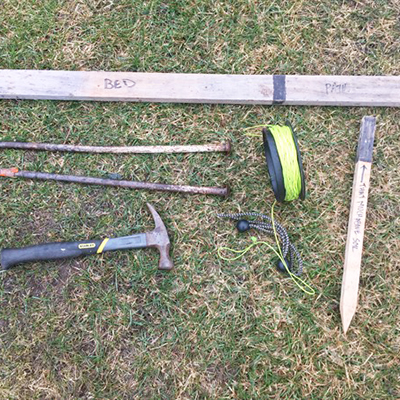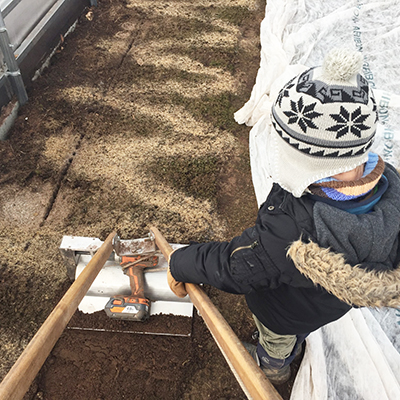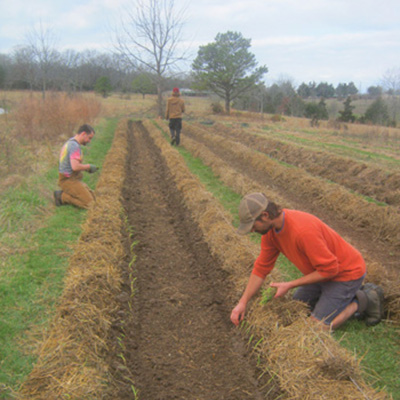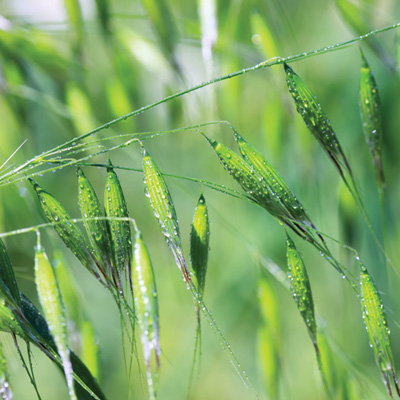By Andrew Mefferd
There are good reasons why quick-growing greens crops have gotten a lot of attention in no-till systems. But I wanted to try growing some less common no-till crops, so I grew test plots of potatoes and sweet potatoes on my farm this past year.
One of the often-cited economic advantages of no-till systems is the ability to harvest and replant a crop quickly. Without having to wait to rototill and remake beds before replanting, more cycles of quick crops like lettuce and radishes can be squeezed into each bed.
Quick-cycling crop economics do not apply to potatoes since they take up most of the growing season on any given piece of land here in Maine or almost anywhere for that matter. It’s not like you can harvest and replant a field for a second or third crop of potatoes in most places.
Potatoes were one of the things we STOPPED growing to sell at the farmers market when we moved our farm from Pennsylvania to Maine. Maine is such a big potato producer that people were just not impressed with our beautiful spuds out there on the market stand.
But in Gabe Brown’s book Dirt to Soil, he describes a no-till method where he lays the seed pieces out on a bed and rolls a round bale over them to cover them.
Since I was already going to try no-till potatoes, when my son requested that we grow sweet potatoes, I thought it would be a fun little trial to do both types of potatoes.
The beauty of the methods I tried is that you don’t have to completely reinvent the wheel to try them. If you already have systems for potatoes and sweet potatoes- timing, spacing, fertility, etc- you can keep all that stuff and just use a different method to get them in the ground.
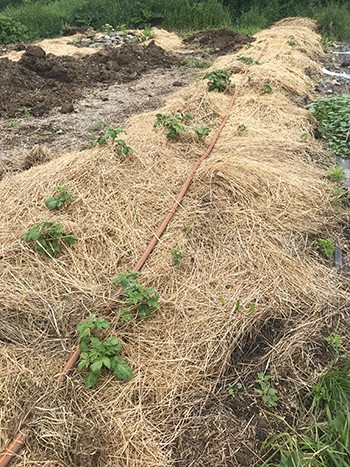
No-till potatoes
I had a 60’ bed available in a garden that had been under a tarp since the previous fall. We were hoping that several months under the tarp would germinate and smother weeds, and leave it ready for planting as early as the snow melted.
This worked well as most of the annual weeds were gone by the spring. There were a few hardy perennial weeds that remained, and a few annuals at the edges of the tarp. So in late May I spread a little bit of fertilizer based on a soil test, and placed a variety of seed potatoes on the bed about a foot apart in the row, with two rows on a 30” bed.
Then I got a spoiled round bale of hay that I already had, rolled it over the top of the potatoes, and walked away. Potatoes, on top of the ground, with hay covering it up. I wondered how they would do. It was a very busy spring, so this was about my speed.
It’s worth pointing out that this was nice soil the potatoes were going on top of- part of the reason we made the spot a garden is because a dairy farmer had made a huge manure pile there when spreading years ago. So it has been fertile and high in organic matter ever since.
I planted these potatoes during what turned out to be a dry spell. After a while, when there were no signs of anything happening under the straw, I started to wonder if they had dried out and died down there? I thought maybe my seed potatoes were imprisoned in a cage of dry hay.
Just in case, I got out a soaker hose, ran it down the length of the bed and made it rain on the potatoes. I’m sure they would have been fine, I was probably just anxious for my little experiment to work, because a few days later the potatoes finally emerged. They very quickly expanded into a row of potatoes that looked just like any other.
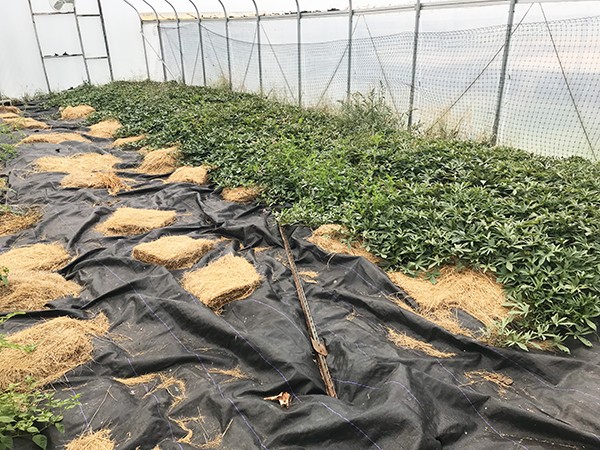
After that, I did very little to them until I came back and harvested. The crop was not irrigated after the initial anxiety, though we did have fairly regular rains through the summer. Once, I made an effort to pull the Colorado Potato Beetle larvae off, but I by no means got all of them and they were never sprayed.
In the end, I got them out of the ground the opposite of the way I got them in: by unrolling the hay. Now this bale was somewhat rotten to start with, so when I tried to re-roll it, it came away in chunks. It was fun to see the potatoes set in their little clutches around the plant as I pulled the hay off.
But the hay did it’s job of suppressing weeds. There were very few as I pulled the hay off. Like I said, it’s been a while since we grew potatoes so I don’t know what people are expecting yield-wise, but we got about 150 pounds of potatoes out of 60 bed feet.
And the potatoes were pretty clean, having been sandwiched between soil and hay. The standout variety was Magic Molly. None of the potatoes had a lot of scab or blemishes, but Magic Molly was notable for the almost perfect packout of number ones.
No-till sweet potatoes
I took inspiration from this article in the GFM archives, which describes the author’s low/minimal tillage method for growing sweet potatoes.
I put the sweet potatoes in a 40’ bed in an unheated hoophouse. This was partially because the last time we tried growing sweet potatoes, on a small commercial scale, outdoors, un irrigated, here in Maine, they did not yield well.
They grew great- the vines were beautiful, and looked like there would be a bumper crop lurking underneath. However that late fall was very dry, and I’m afraid that the plants didn’t get enough water to size up the potatoes.
So, I put them in my hoophouse because they would get water, and I figure here in Maine it couldn’t hurt to try to trick the sweet potatoes into thinking they were at least a couple states south.
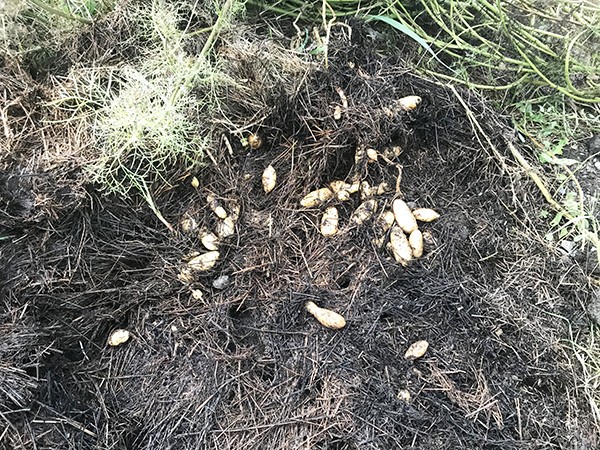
The story from here on out is almost disappointingly simple. I had a bed in the hoophouse that I had applied compost and fertilizer to the previous fall, and then tarped it over the winter. I wasn’t sure what was going to go there the previous fall, but I knew I wanted it to be ready for something.
So I plugged the sweet potatoes in there. When I pulled the cover back in May after being covered all winter, the soil was soft from freezing and thawing all winter long. I made holes with my fingers, poked sweet potato slips in and firmed them into the ground.
Our occultation hadn’t gotten all the weed seeds, because some definitely came up. But after weeding the bed twice, we didn’t do much to them other than checking to make sure the irrigation was working occasionally.
Finally, on October 6, we dug the sweet potatoes. They would have gotten frosted in the field by that date here, but being in a hoophouse cut us a little slack. We got about 100 pounds from our 40 feet of bed. Far less than commercial growers strive for, I’m sure, but the amount of vole damage has me wishing that I had harvested them a little earlier, and wondering how many pounds the voles got.
This little experiment proved to myself that no-till potatoes are a viable option for me. I like the set-it-and-forget-it nature of both systems, though we probably could have gotten some more potatoes if we had top dressed them with straw or something else to simulate hilling.
I imagine a big question in growers’ minds at this point is whether these growing methods are compatible with their harvest systems. If you harvest by hand, no problem then, if anything this is easier because you’re digging through hay not soil. On the other hand, if you’re used to mechanical harvest, it’s impossible to tell how well any given harvester will deal with all that hay without trying it.
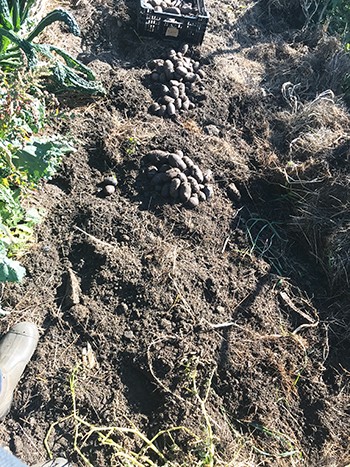
I have heard some no-till growers say that they don’t grow root crops because the soil disturbance needed to harvest them is more than they want. On the other hand, if I had a market for potatoes, I would probably grow them in a rotation with other crops, and hope that any damage to the soil from the harvesting method would be made up for by good soil stewardship, and several years out of root crops.
Another issue is that an invasive harvest method like most potato diggers may churn up buried weed seeds. In my book, The Organic No-Till Farming Revolution, I interviewed Polly Armour of Four Winds Farm about how they have a special rotation in their no-till system following potatoes. Here’s Polly, from the book, on that rotation:
“Potatoes are the disruptor. We move the potatoes around the farm on a three-year rotation program, and when we harvest the potatoes, because they're a big tuber underground, it ends up disrupting the beds,” said Polly.
“Does that mean you get weeds that sprout up there?” I asked.
“We would get weeds if we didn't cover the soil right away. A strategy that we discovered was to plant garlic in the fall and then put compost down on top of the garlic. This way we are both mulching the garlic and covering up bare ground,” said Jay.
“We do a mixed crop the year following potatoes of garlic and winter squash. As soon as these potatoes come out, the beds will be rebuilt with a potato hiller,” said Polly.
“The soil that has gotten dumped into the pathways is put back into the beds, and then we plant garlic in alternate beds, and we cover it with compost. We cover the other beds with the compost, as well, and that smothers any weeds that are going to come up. The garlic will stay there all winter. The following spring, we put winter squash in the empty beds. The garlic comes out in early summer, which is right when the winter squash wants to take over. We just let the winter squash take over, and that's how we suppress the weeds [where the potatoes were], which is the only spot that really gets disrupted,” said Polly.
Andrew Mefferd is the Editor of Growing for Market Magazine. He is the author of The Organic No-Till Farming Revolution, and The Greenhouse and Hoophouse Grower’s Handbook.

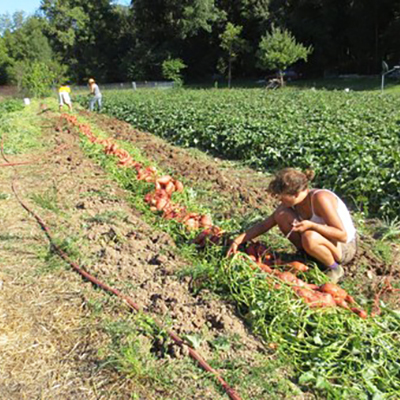

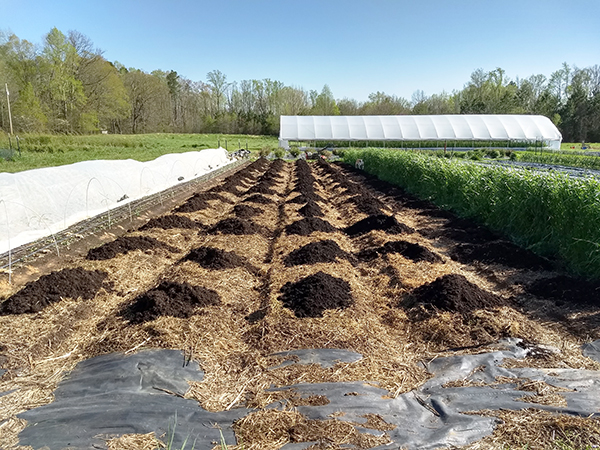 My wife, Megan, and I grow cut flowers on half an acre of a twelve-acre property in Hurdle Mills, NC. We are in the heart of tobacco country. When we bought our property in 2013, our sales contract stipulated that the farmer had the right to harvest that year’s tobacco crop. Based on our best guesses, that marked at least the 100th consecutive year of tobacco/wheat rotations on this property. The farmer was kind enough to disc in the tobacco stubble after the harvest.
My wife, Megan, and I grow cut flowers on half an acre of a twelve-acre property in Hurdle Mills, NC. We are in the heart of tobacco country. When we bought our property in 2013, our sales contract stipulated that the farmer had the right to harvest that year’s tobacco crop. Based on our best guesses, that marked at least the 100th consecutive year of tobacco/wheat rotations on this property. The farmer was kind enough to disc in the tobacco stubble after the harvest.
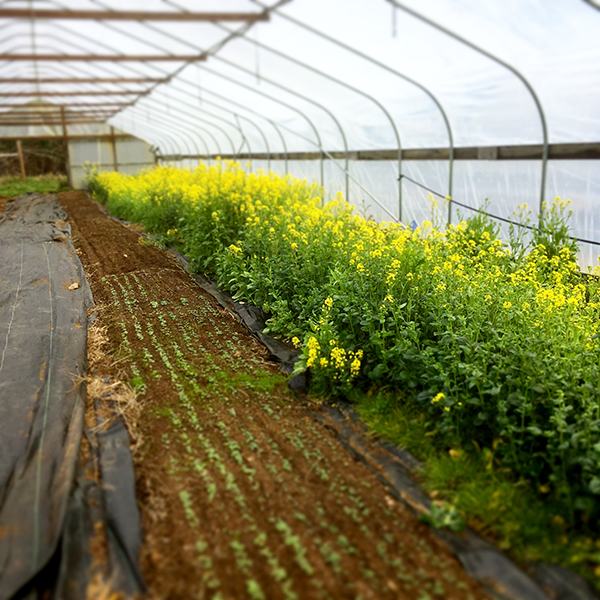 If you’ve been a subscriber to Growing For Market (or even if you haven’t), you’re probably familiar with the many advantages of no-till agriculture. No-till methods can reduce a farm’s carbon footprint, promote complex soil biology, and preserve and build organic matter.
If you’ve been a subscriber to Growing For Market (or even if you haven’t), you’re probably familiar with the many advantages of no-till agriculture. No-till methods can reduce a farm’s carbon footprint, promote complex soil biology, and preserve and build organic matter.
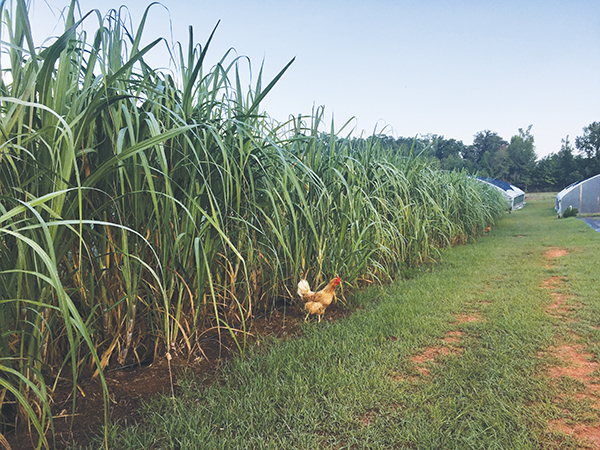 Julia Asherman appeared on my radar screen a number of years ago because she was a regular presence at the Southern Sustainable Agriculture Working Group conferences where I’ve spoken many times. Colleagues pointed her out to me as a person to watch because she was tough and smart and she was going to make something of herself as a farmer. We became conference buddies. So, when I had the good fortune to get invited to speak at the Georgia Organics Conference in Athens this winter, I knew right away I wanted to take that opportunity to visit Julia at her place, Rag & Frass Farm in Jeffersonville, Georgia.
Julia Asherman appeared on my radar screen a number of years ago because she was a regular presence at the Southern Sustainable Agriculture Working Group conferences where I’ve spoken many times. Colleagues pointed her out to me as a person to watch because she was tough and smart and she was going to make something of herself as a farmer. We became conference buddies. So, when I had the good fortune to get invited to speak at the Georgia Organics Conference in Athens this winter, I knew right away I wanted to take that opportunity to visit Julia at her place, Rag & Frass Farm in Jeffersonville, Georgia.
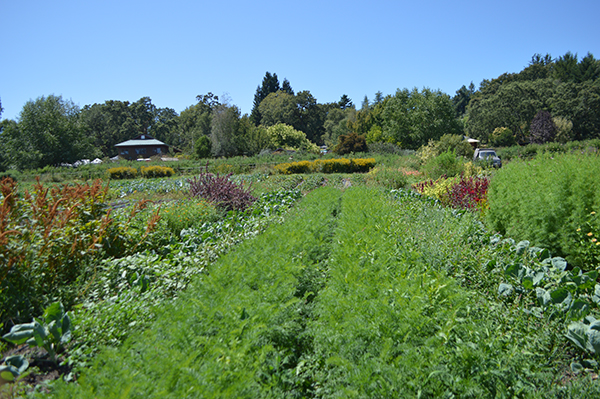 Farmer to Farmer Profile
Farmer to Farmer Profile
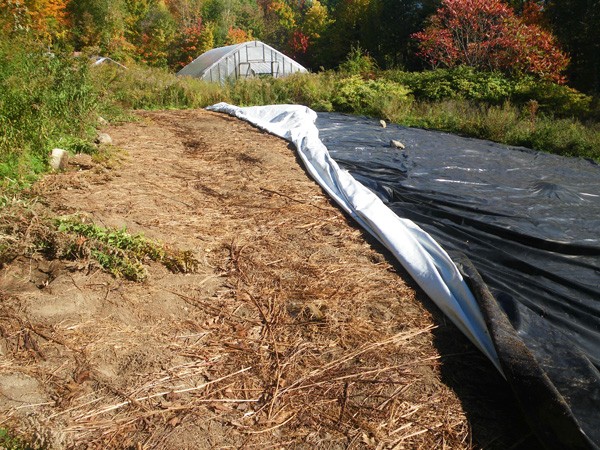 In the mid-1980s I had a farm in upstate New York and grew 20 acres of organic vegetables with machinery. It was organic, but not sustainable both for the use of fossil fuel and high level of personal burnout. I lost my joy of farming and never thought I would go back into it for my livelihood.
In the mid-1980s I had a farm in upstate New York and grew 20 acres of organic vegetables with machinery. It was organic, but not sustainable both for the use of fossil fuel and high level of personal burnout. I lost my joy of farming and never thought I would go back into it for my livelihood.
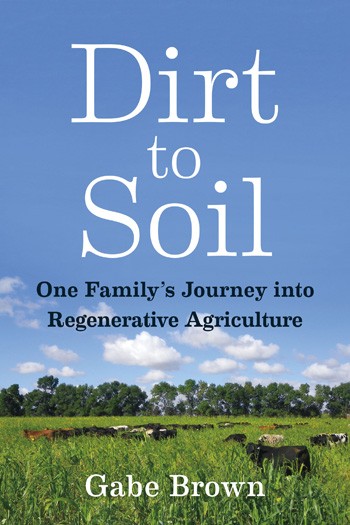 In recent years a great deal of interest has been building around the question of how to run a profitable, chemical-free farm without tillage. We all know what tillage does to soil, but the available information about how not to till on a commercial market garden scale has felt impractical or unusable, much of it geared towards home gardeners or mega grain operations in chemical monoculture. There has been, to be sure, very little in the way of guidance on how to approach a profitable, diversified no-till farm.
In recent years a great deal of interest has been building around the question of how to run a profitable, chemical-free farm without tillage. We all know what tillage does to soil, but the available information about how not to till on a commercial market garden scale has felt impractical or unusable, much of it geared towards home gardeners or mega grain operations in chemical monoculture. There has been, to be sure, very little in the way of guidance on how to approach a profitable, diversified no-till farm. 
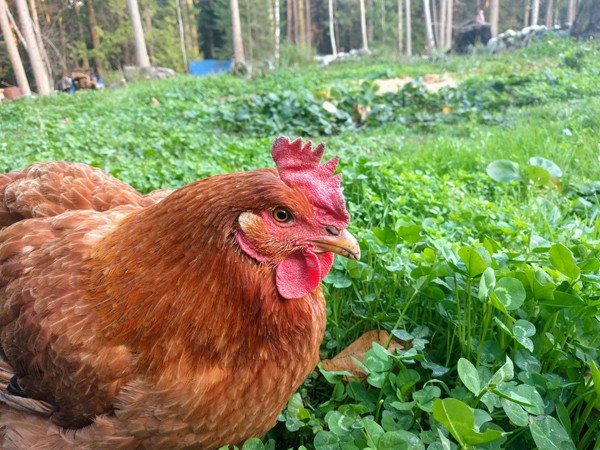 The modern age could very well be termed the age of carbon. We have increased the amount of carbon dioxide (CO2) in the atmosphere by more than a third since the Industrial Revolution began. A gas that keeps heat from the sun contained within the earth’s atmosphere, CO2 makes up more than three-quarters of the greenhouse gas emissions in the world. At the same time agriculture is currently experiencing a carbon crisis, with 50-70% of the world’s carbon in farmland soils off-gassed into the atmosphere due to tillage. Carbon is the single most essential element in soil fertility as it aids soil structure development, water retention, nutrient retention, and biological processes.
The modern age could very well be termed the age of carbon. We have increased the amount of carbon dioxide (CO2) in the atmosphere by more than a third since the Industrial Revolution began. A gas that keeps heat from the sun contained within the earth’s atmosphere, CO2 makes up more than three-quarters of the greenhouse gas emissions in the world. At the same time agriculture is currently experiencing a carbon crisis, with 50-70% of the world’s carbon in farmland soils off-gassed into the atmosphere due to tillage. Carbon is the single most essential element in soil fertility as it aids soil structure development, water retention, nutrient retention, and biological processes. 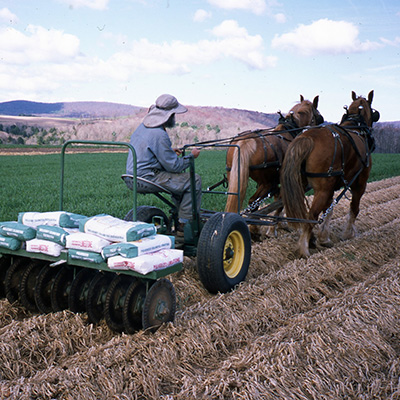
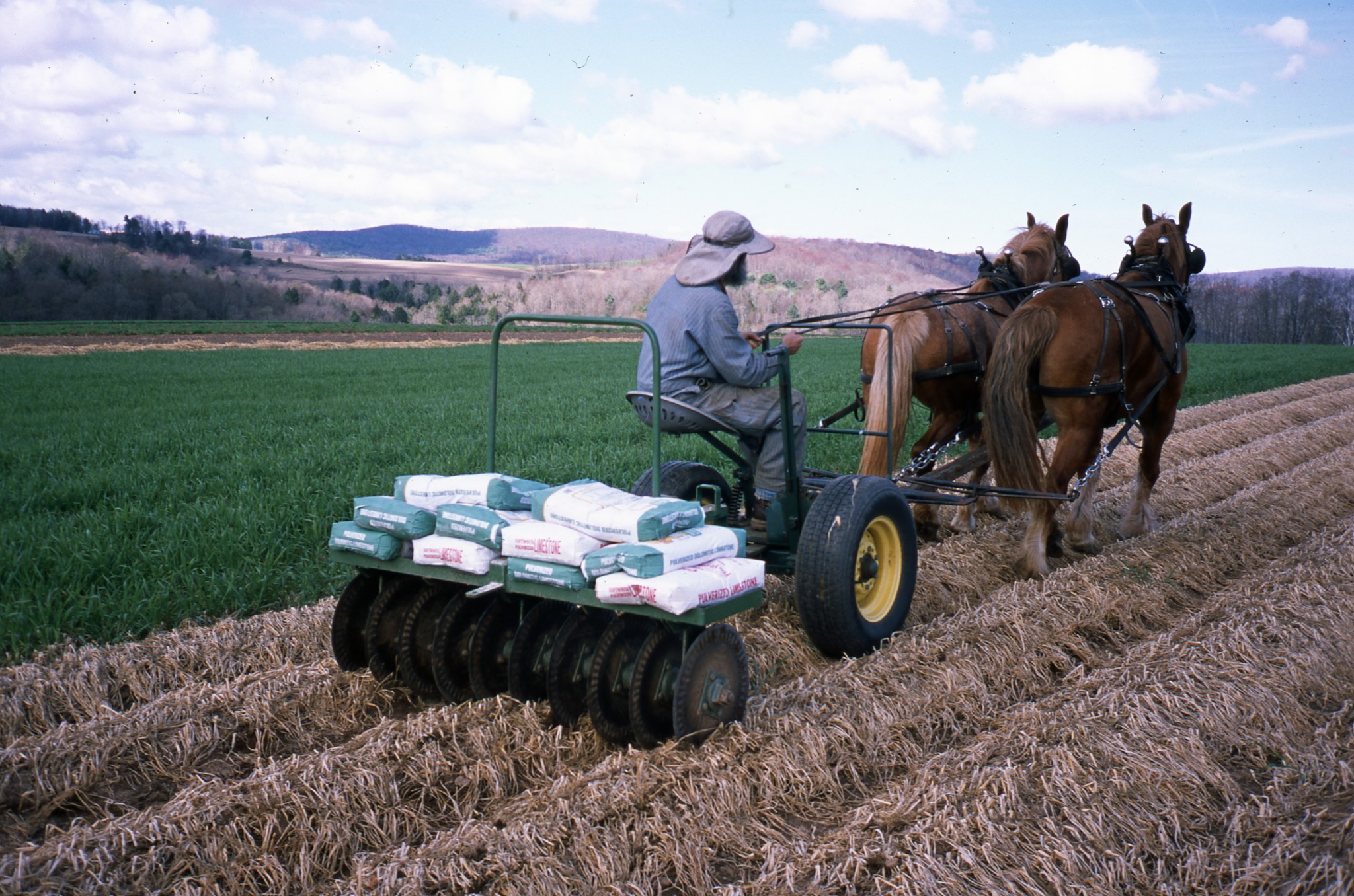 When we started farming in 1983, there were few models of organic, horse-powered market gardening. So we used the traditional practices for growing field crops here in north-central Pennsylvania, preparing a seedbed with the moldboard plow, spring tooth harrow and cultipacker. We quickly realized we needed to put a whoa on moldboard plowing to dependably establish dryland produce.
When we started farming in 1983, there were few models of organic, horse-powered market gardening. So we used the traditional practices for growing field crops here in north-central Pennsylvania, preparing a seedbed with the moldboard plow, spring tooth harrow and cultipacker. We quickly realized we needed to put a whoa on moldboard plowing to dependably establish dryland produce.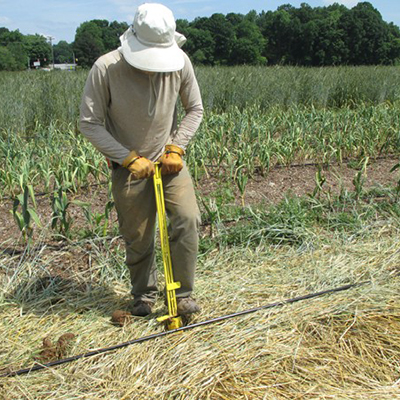
 Organic no-till and mulching systems are a huge time saver on our farm. They’ve allowed us to increase production while reducing labor on our six acres of vegetable production. This spring was our easiest year yet even though an illness in April made it difficult to leave the house. I owe the time savings to the roller crimper.
Organic no-till and mulching systems are a huge time saver on our farm. They’ve allowed us to increase production while reducing labor on our six acres of vegetable production. This spring was our easiest year yet even though an illness in April made it difficult to leave the house. I owe the time savings to the roller crimper. 